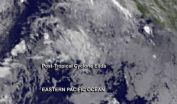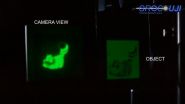(Press-News.org) Strong northwesterly wind shear took its toll on Tropical Storm Elida, weakening it to a remnant low early on July 2. In infrared satellite imagery from NOAA's GOES-West satellite, Elida appeared to be a tight swirl of low clouds devoid of any deep convection.
Infrared satellite instruments are used to see the heat objects emit. During night-time hours when there's no sunlight to light clouds, satellites like NOAA's Geostationary Operational Environmental Satellite or GOES-West satellite looks at clouds in infrared light. Infrared data from NOAA's GOES-West satellite on July 2 at 9:00 UTC (5 a.m. EDT) was made into an image at NASA/NOAA's GOES Project at the NASA Goddard Space Flight Center in Greenbelt, Md. The image showed Elida was almost devoid of convection (rising air that creates powerful thunderstorms that make up a tropical cyclone).
The National Hurricane Center or NHC issued their final bulletin on Elida on Wednesday, July 2 at 5 a.m. EDT (9:00 UTC). Maximum sustained winds were near 30 mph (45 kph) and weakening. The center of Post-Tropical Cyclone Elide was located near latitude 16.9 north and longitude 103.0 west, about 170 miles (270 km) south-southeast of Manzanillo Mexico The post-tropical cyclone is moving toward the southeast near 3 mph (6 kph).
The NHC expects the remnants to move westward by Thursday due to a building low-level ridge (elongated area of high pressure) over the eastern Pacific. By July fourth, Eilda's remnants are expected to degenerate into a trough or elongated area of low pressure.
INFORMATION:
Wind shear wipes out Tropical Cyclone Elida
2014-07-02
ELSE PRESS RELEASES FROM THIS DATE:
Georgia Tech researchers develop 'Encore' to monitor Web access
2014-07-02
Georgia Tech researchers have created a tool to monitor the accessibility of Web pages around the world that can be installed by adding a single line of code to a web page. The tool, Encore, runs when a user visits a website where the code is installed and then discreetly collects data from potentially censored sites.
The researchers hope the data they collect will allow them to determine the wheres, whens and hows of what's blocked, as well as identify ways to get around restricted access.
"Web censorship is a growing problem affecting users in an increasing number ...
NASA's TRMM satellite spots heavy rainfall around Tropical Storm Arthur's center
2014-07-02
Tropical Storm Arthur appears to be ramping up, and NASA's Tropical Rainfall Measuring Mission or TRMM satellite spotted heavy rainfall occurring around the storm's center on July 1 when it was centered over the Bahamas.
Those heavy rains are expected to affect the southern U.S. coastline over the next several days as the National Hurricane Center expects Arthur to strengthen into a hurricane. On July 2, the NHC issued a Hurricane Watch for Bogue Inlet to Oregon Inlet, North Carolina and Pamlico Sound. In addition, a Tropical Storm Watch is in effect for the east coast ...
NASA sees a weaker Tropical Storm Douglas
2014-07-02
NASA's Aqua satellite captured a picture of Tropical Storm Douglas as it began moving into cooler waters in the Eastern Pacific Ocean. Those cooler waters, coupled with drier air are expected to bring about the storm's demise, according to the National Hurricane Center.
A visible image of Tropical Storm Douglas was taken by the Moderate Resolution Imaging Spectroradiometer or MODIS instrument aboard NASA's Aqua satellite on July 1 at 21:20 UTC (5:20 p.m. EDT). The thickest band of thunderstorms appeared over the southern semi-circle of the weakening storm while bands ...
Squid sucker ring teeth material could aid reconstructive surgery, serve as eco-packaging
2014-07-02
Squid tentacles are loaded with hundreds of suction cups, or suckers, and each sucker has a ring of razor-sharp "teeth" that help these mighty predators latch onto and take down prey. In a study published in the journal ACS Nano, researchers report that the proteins in these teeth could form the basis for a new generation of strong, but malleable, materials that could someday be used for reconstructive surgery, eco-friendly packaging and many other applications.
Ali Miserez and colleagues explain that in previous research, they discovered that sharp, tough squid sucker ...
'Green buildings' have potential to improve health of low-income housing residents
2014-07-02
The "green building" trend is often associated with helping the environment by using eco-friendly materials and energy-saving techniques, but these practices are designed to improve people's health, too. Now scientists are reporting evidence that they can indeed help people feel better, including those living in low-income housing. Published in ACS' journal Environmental Science & Technology, the study found that certain health problems of public housing residents who moved into green buildings noticeably improved.
Gary Adamkiewicz, Meryl Colton and colleagues note that ...
Toward a new way to keep electronics from overheating
2014-07-02
Computer technology has transformed the way we live, but as consumers expect ever more from their devices at faster speeds, personal computers as well as larger electronic systems can overheat. This can cause them to slow down, or worse, completely shut down. Now researchers are reporting in the ACS journal Industrial & Engineering Chemistry Research that liquids containing nanoparticles could help devices stay cool and keep them running.
Rahman Saidur and colleagues point out that consumers demand a lot out of their gadgets. But that puts a huge strain on the tiny parts ...
Overcoming light scattering: New optical system sees deeper inside tissue
2014-07-02
VIDEO:
After the diffuser, the information content of the object is scrambled so that the light distribution at the pixelated sensor looks like the familiar speckle noise.
Click here for more information.
Optical imaging methods are rapidly becoming essential tools in biomedical science because they're noninvasive, fast, cost-efficient and pose no health risks since they don't use ionizing radiation. These methods could become even more valuable if researchers could find a way ...
Becoming an expert takes more than practice
2014-07-02
Deliberate practice may not have nearly as much influence in building expertise as we thought, according to research published in Psychological Science, a journal of the Association for Psychological Science.
Scientists have been studying and debating whether experts are "born" or "made" since the mid-1800s. In recent years, deliberate practice has received considerable attention in these debates, while innate ability has been pushed to the side, due in part to the famous "10,000-hour rule" coined by Malcolm Gladwell in his 2008 book Outliers.
The new study, from psychological ...
Joslin scientists identify process that affects fat distribution and metabolic syndrome
2014-07-02
BOSTON – July 1, 2014 – Building upon their earlier research on the biology of fat metabolism, Joslin scientists discovered that microRNAs –small RNA molecules that play important roles in regulation in many types of tissue – play a major role in the distribution and determination of fat cells and whole body metabolism. Also, the study is the first to reveal that microRNAs (miRNAs) influence the development of lipodystrophy (abnormal fat accumulation) which affects many people with HIV receiving anti-retroviral therapy. The findings appear in the August issue of the Journal ...
UH researchers identify one of world's thinnest piezoelectric materials
2014-07-02
HOUSTON, July 1, 2014 – There are a handful of naturally occurring materials, known as piezoelectric materials, that generate electricity if you bend, stretch or apply another mechanical force to them, and vice versa – if you apply a voltage across them, they'll deform accordingly. These materials are currently the subject of intense research for their potential applications in energy harvesting, artificial muscles and sensors, among others. These materials are also used in everyday devices, such as loudspeakers, which rely on piezoelectrics to convert electrical signals ...





